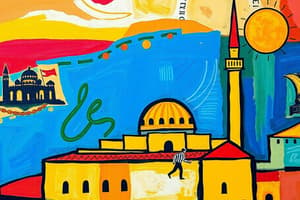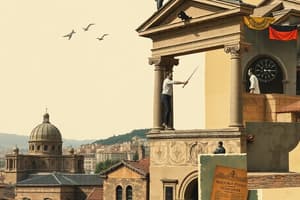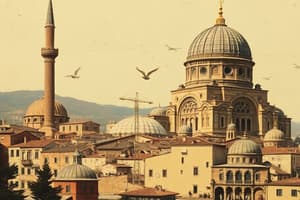Podcast
Questions and Answers
Which of the following factors contributed most significantly to Constantinople's strategic importance during the Byzantine era?
Which of the following factors contributed most significantly to Constantinople's strategic importance during the Byzantine era?
- Its proximity to major gold mines which funded the empire.
- Its control over key trade routes between the Aegean and Black Seas. (correct)
- Its role as a major religious center for pilgrimage.
- Its vast agricultural lands which fed the empire.
Constantin I's decision rationale to move the Roman Empire's capital to Byzance was MOST motivated by:
Constantin I's decision rationale to move the Roman Empire's capital to Byzance was MOST motivated by:
- a wish to establish a new capital that would reflect his personal power and glory. (correct)
- the need for a location that was easier to defend against naval attacks.
- a desire to escape the colder climate of Rome.
- Byzance having a smaller population than Rome.
What was the primary strategic advantage provided by the Theodosian Walls built in 412?
What was the primary strategic advantage provided by the Theodosian Walls built in 412?
- Providing a symbolic representation of Roman architectural skill.
- Protecting the city from earthquakes.
- Facilitating trade with neighboring empires.
- Offering an impenetrable defense that lasted for over a millennium. (correct)
Which of the following statements best describes Constantinople's role after the fall of the Western Roman Empire?
Which of the following statements best describes Constantinople's role after the fall of the Western Roman Empire?
What was Mehmed II's primary motivation for wanting to conquer Constantinople?
What was Mehmed II's primary motivation for wanting to conquer Constantinople?
Which challenge did Mehmed II face during his initial reign before consolidating power and focusing on Constantinople?
Which challenge did Mehmed II face during his initial reign before consolidating power and focusing on Constantinople?
Why did Mehmed II consider the control of the Bosphorus Strait critical for the Ottoman Empire?
Why did Mehmed II consider the control of the Bosphorus Strait critical for the Ottoman Empire?
What strategic measures did Mehmed II undertake to prepare for the siege of Constantinople?
What strategic measures did Mehmed II undertake to prepare for the siege of Constantinople?
Despite the Ottoman's efforts during the siege of Constantinople in 1453, what factor initially hindered their naval efforts?
Despite the Ottoman's efforts during the siege of Constantinople in 1453, what factor initially hindered their naval efforts?
Before focusing on conquering Constantinople, Mehmed II prioritized:
Before focusing on conquering Constantinople, Mehmed II prioritized:
What strategic advantage did transporting ships over land provide Mehmed II during the siege of Constantinople?
What strategic advantage did transporting ships over land provide Mehmed II during the siege of Constantinople?
What was Djandarli Khalil Pacha's primary concern that influenced his stance on the siege of Constantinople?
What was Djandarli Khalil Pacha's primary concern that influenced his stance on the siege of Constantinople?
Which of the following best describes Mehmed II's actions immediately following the capture of Constantinople?
Which of the following best describes Mehmed II's actions immediately following the capture of Constantinople?
What was the main purpose behind Mehmed II's reconstruction and repopulation efforts in Constantinople?
What was the main purpose behind Mehmed II's reconstruction and repopulation efforts in Constantinople?
In addition to conquering Constantinople, what other strategic accomplishment did Mehmed II achieve in 1453 that solidified his control over the region?
In addition to conquering Constantinople, what other strategic accomplishment did Mehmed II achieve in 1453 that solidified his control over the region?
Which of the following best describes Mehmed II's approach to religious matters within his expanding empire?
Which of the following best describes Mehmed II's approach to religious matters within his expanding empire?
Why did European intellectuals and monarchs attempt to convert Mehmed II to Christianity?
Why did European intellectuals and monarchs attempt to convert Mehmed II to Christianity?
How did Mehmed II integrate Byzantine heritage into his vision for the Ottoman Empire?
How did Mehmed II integrate Byzantine heritage into his vision for the Ottoman Empire?
What was the purpose of Mehmed II's Kânnûname legislative code?
What was the purpose of Mehmed II's Kânnûname legislative code?
Which of the following factors contributed to the instability of the Ottoman Empire at the time of Mehmed II's death in 1481?
Which of the following factors contributed to the instability of the Ottoman Empire at the time of Mehmed II's death in 1481?
Flashcards
Basilica Cistern
Basilica Cistern
An ancient underground cistern in Istanbul, built when the city was known as Constantinople.
Byzance's Strategic Importance
Byzance's Strategic Importance
Its location on the Bosphorus Strait allowed control over passage between the Aegean and Black Seas.
Constantin Ier's Vision
Constantin Ier's Vision
Constantin I sought a new capital for the Roman Empire in 324 AD, renaming Byzance to Kônstantinoúpolis.
Théodose's Fortification
Théodose's Fortification
Signup and view all the flashcards
Constantinople - Cosmopolitan Hub
Constantinople - Cosmopolitan Hub
Signup and view all the flashcards
Importance of Constantinople
Importance of Constantinople
Signup and view all the flashcards
Mehmed II's Ambition
Mehmed II's Ambition
Signup and view all the flashcards
Mehmed II's Early Reign
Mehmed II's Early Reign
Signup and view all the flashcards
Mehmed II's Strategy
Mehmed II's Strategy
Signup and view all the flashcards
Mehmed II's Preparations
Mehmed II's Preparations
Signup and view all the flashcards
Ship Transportation
Ship Transportation
Signup and view all the flashcards
Internal Fears During Siege
Internal Fears During Siege
Signup and view all the flashcards
Fall of Constantinople Date
Fall of Constantinople Date
Signup and view all the flashcards
Mehmed's Dual Authority
Mehmed's Dual Authority
Signup and view all the flashcards
Constantinople's Reconstruction
Constantinople's Reconstruction
Signup and view all the flashcards
Mehmed's Military Campaigns
Mehmed's Military Campaigns
Signup and view all the flashcards
Byzantine Elite Integration
Byzantine Elite Integration
Signup and view all the flashcards
Gennadios' Role
Gennadios' Role
Signup and view all the flashcards
Mehmed's Artistic Pursuits
Mehmed's Artistic Pursuits
Signup and view all the flashcards
Kânnûnamê
Kânnûnamê
Signup and view all the flashcards
Study Notes
Yerebatan Sarnici (Basilica Cistern)
- Located in Istanbul, serving as a "cathedral of shadows" beneath the city
- Dates back to when Istanbul was known as Constantinople
Byzance's Strategic Importance
- Situated on the Bosphorus
- Allowed inhabitants to control passage between the Aegean Sea and the Black Sea
- Formerly a modest Greek city known as Byzance
Constantin Ier's Vision
- In 324, Constantin sought a new capital for the Roman Empire, that was less crowded than Rome
- It was meant as an obvious symbol of his personal glory
- Byzance was renamed Kônstantinoúpolis ("city of Constantine")
Kônstantinoúpolis' Expansion
- The city's surface area quadrupled
- New ports were constructed for trade and warfare
- Numerous forums, aqueducts, churches, basilicas, and an imperial palace were erected
Théodose's Fortification
- In 412, Emperor Théodose ordered the construction of an imposing new wall
- It symbolized Roman military skill
- Proved impenetrable for over a millennium
Constantinople's Rise
- After the fall of the Western Roman Empire in 476, the former Kônstantinoúpolis became the undisputed capital of the Roman world
- Population exceeded one million
Constantinople - A Cosmopolitan Hub
- Churches, synagogues, and mosques arose, marking the city as a major commercial center
- Peoples from Europe, the Middle East, and Central Asian steppes converged
- The Eastern Roman Empire, later known as the Byzantine Empire, faced invasions and civil wars, leading to its decline
The Fall of Constantinople
- By 1453, only remnants of the Byzantine Empire remained, including parts of southern Greece and Constantinople itself
- The city was a symbol of the empire's existence
- The empire could not vanish as long as the city stood
Mehmed II's Ambition
- Mehmed II, the young sultan of the Ottoman Empire, wanted to capture Constantinople, and transform it into his capital
- He aimed to grant the Ottomans global prominence
- He recognized the need to breach the walls of Théodose
Mehmed II's Early Reign
- Mehmed II's early reign began with challenges
- His father, Mourad II, abdicated in 1444 to dedicate his life to prayer
- Mehmed, only 12 years old, succeeded him
- The child-sultan had a bad temper, and clashed with Grand Vizier Djandarli Khalil Pacha, disrupting government operations
- A popular revolt broke out and Edirne, the Ottoman capital, was set on fire
- Mehmed, now 13, had to face a crusade launched by the Venetians
Mourad II's Return
- Djandarli Khalil Pacha summoned Mourad II back to power amidst the crisis
- After the war, Mourad wanted to retire again, but the janissaries revolted, rejecting Mehmed's authority
- Mourad had no choice but to remain in power until his death in 1451
Mehmed II's Strategy
- Upon his second ascension, Mehmed II decided to conquer Constantinople to maintain power
- In 1451, the remnants of the Byzantine Empire troubled the Ottomans
- Constantinople's location on the Bosphorus Strait hindered Ottoman passage between Europe and Asia
Mehmed II's Consolidation
- Mehmed argued that controlling the Bosphorus was vital for the empire's security
- He retained most of Mourad's advisors and provided gifts to the janissaries
Mehmed II's Preparations
- Mehmed could not afford failure
- He renewed peace with neighboring states;
- He gathered his father's well-trained armies
- Rumeli Hisari fortress was built to control the region
- A fleet was developed to prevent Constantinople from being resupplied
- Greek territories in the south were occupied
- Modern artillery, including a giant bombards, was developed
The Siege of Constantinople
- The siege of Constantinople began on April 2, 1453
- Mehmed was 21 years old
- Despite Ottoman assaults and artillery fire, the defenders held firm
- The Byzantines, supported by Genoese and Catalans, restored their defenses
Naval Challenges
- Mehmed's new fleet was ineffective
- Italian and Greek ships bypassed the blockade and resupplied the Byzantines.
- The Turkish ships could not approach city due its port being protected by a chain
- He transported ships over the Galata neighborhood to blockade the Bosphorus and the Golden Horn
- Constantinople's ports found themselves between two fires, and a boat bridge eased troop movement
Internal Conflicts
- Ministers argued whether to lift the siege
- Djandarli Khalil Pacha feared invasions by Hungarians, Venetians, the Pope, and Albanians
- A final assault was planned for May 28, 1453
The Final Assault
- Mehmed planned every battalion's movement
- On May 29, 1453, the Roman Empire of the Orient ceased to exist
Konstantiniyye's Rebirth
- With the capture of Constantinople, now Konstantiniyye, Mehmed gained authority and became the heir to both Mahomet and the Roman emperors
- The city was in ruins
- It had been impoverished since the 13th century
- The population was about 40,000
- Mehmed ended pillaging after two days and freed his slaves
Reconstruction Efforts
- Mehmed II ordered the city's reconstruction
- Constantinople should become new center of the world
- Walls were repaired, markets, aqueducts, and cisterns were restored, and entire streets were repopulated
- Construction of Topkapi Palace began around 1460
- Ministers were "voluntarily " asked to help fund mosques, hospitals, libraries, bathhouses, and markets
Mehmed II, "The Conqueror"
- Mehmed II was nicknamed "Fatih," meaning "the conqueror"
- He conducted wars on multiple fronts
Military Campaigns
- Before attacking the Byzantines, he annexed the Turkish sultanate of Karamanides
- In 1453, he secured his new capital by invading Genoese possessions in the Black Sea and Aegean Sea
- He subjugated the Greeks in the south
- The Ottomans and Hungarians clashed in the Balkans
- Venice engaged in costly wars against the Turks
Anatolian Conquests
- Mehmed II conquered Trébizonde and several Turkish emirates
- He also subdued the sultan of Aq Qolunyu Akkoyunlular
Setbacks
- Albania resisted Ottoman invasions and allied with the Pope, Venetians, and Hungarians
- The knights Hospitallers of Rhodes remained a nuisance for the Ottomans
Mehmed II's Cultural Policies
- Mehmed II integrated Byzantine elites into the Ottoman administration
- He sought recognition as master rather than solely as head of muslims
Religious Tolerance Integration
- Mehmed enlisted monk Gennadios as the new patriarch of Constantinople
- He entrusted Gennadios with protecting the rights of Orthodox Christians in his empire
- Despite Christian sympathies, tensions arose among Muslims
Religious Rumors
- Rumors arose that Mehmed II had converted to Christianity
- European intellectuals and monarchs attempted to convert the sultan
Mehmed II's Religious Approach
- Mehmed engaged with Christians and Jews to secure their allegiance and unify his empire
- Priests and rabbis sought assurances that their communities would persist without persecution
Artistic Pursuits
- Mehmed II displayed a passion for the arts
- The overall restructing of Constantinople was work of open-air art
Mehmed II's Cultural and Intellectual Pursuits
- Mehmed II defied conservative Muslim views by commissioning Venetian painters for portraits and amassing an art collection comparable to those in Italian Renaissance palaces.
- He embraced the Byzantine heritage, integrating it with Turkish culture and the Muslim religion to establish his universal empire.
- His extensive library contained works from Arab and Persian philosophers and poets, as well as ancient Latin and Greek texts.
- The library also featured detailed atlases and scientific manuals from Muslim and European scholars, reflecting his interest in innovative ideas.
- Mehmed II had a strong interest in new, especially military, technologies to maintain his strategic advantage over enemies.
Mehmed II as a Legislator and Ruler
- Mehmed II codified and clarified existing laws without creating new ones.
- He consolidated laws applicable to non-Muslim communities, presenting himself as their former rulers' successor and earning their trust.
- He reduced certain penalties and fines to appear as a generous and benevolent ruler to non-Muslims.
- In contrast, Mehmed II confronted the Muslim clergy (Ulema) who opposed his authoritarian rule.
- He seized assets from religious foundations which were usually independent and tax-exempt, angering devout believers and Islamic law experts.
- He used traditions and his reputation as a conqueror to suppress legal disputes.
- Mehmed II created the Kânnûnamê, a legislative code defining the rights and duties of his subjects, including local customs, tax systems, penal sanctions, and succession rules.
- To maintain power, the code allowed the Ottoman heir to execute his brothers; Mehmed II killed his youngest brother, invoking this custom.
Conclusion: Mehmed II's Legacy
- Historians debate whether the end of the Middle Ages was in 1492 (the great discoveries) or 1453 (the fall of Constantinople).
- Despite a challenging start, Mehmed II quickly became a capable leader.
- Although tyrannical, he was attentive to administration, arts, and science.
- He strengthened his empire militarily, held off Hungary, weakened Venice, and incorporated Turkish emirates of Anatolia.
- He left a modern army with unmatched artillery upon his death in 1481.
- Mehmed II centralized power, reinforcing his authority over ministers and families through violence, military glory, and bribes to the Janissaries.
- Future heirs would become hostages of these elite soldiers.
- Constantinople was repopulated and rehabilitated, with community leaders appointed to serve the Sultan.
- Mehmed's universalist approach to integrate subjects of all religions offended the Muslim population.
- Mehmed II left behind a vast and powerful empire, but the army was weary, the people divided, and the economy unstable due to currency devaluation.
- Despite a civil war between his sons, his legacy facilitated Selim I's conquest of Egypt and claim of the title of Caliph, and Suleiman the Magnificent's advance to Vienna.
Studying That Suits You
Use AI to generate personalized quizzes and flashcards to suit your learning preferences.



